Best Camping Spots in the United States
The United States offers a vast array of stunning camping spots across its national and state parks. Here are some of the best places to consider for your camping adventure.
- White Mountain National Forest
- Shenandoah National Park
- Big Bend National Park
- Badlands National Park
- Glacier National Park
- Grand Teton National Park
- Arches National Park
- Valley of Fire State Park
- Grand Canyon National Park
- Olympic National Park
- Crater Lake National Park
- Joshua Tree National Park
- Yosemite National Park
- Sequoia and Kings Canyon National Parks
- Haleakalā National Park
- Acadia National Park
- Minnewaska State Park Reserve
- Assateague Island National Seashore
- Dry Tortugas National Park
- Ozark-St. Francis National Forests
White Mountain National Forest:
Immerse yourself in the splendor of New England’s White Mountain National Forest, a premier destination for campers and nature enthusiasts. With its headquarters nestled in Campton, NH, this forest is easily accessible via the scenic Kancamagus Highway, offering a gateway to a world of breathtaking landscapes. From the towering Mount Washington to serene mountain lakes, the forest’s diverse scenery captivates all who visit. Campgrounds equipped with essential amenities ensure a comfortable stay, while backcountry camping invites the more adventurous souls. Embrace the myriad of recreational activities available, from hiking over 1200 miles of trails to winter sports that thrill.

As you plan your camping trip to the White Mountain National Forest, be mindful of the weather and seasonal considerations, as conditions can change rapidly in this mountainous region. Prepare for cool temperatures and occasional rain, ensuring a safe and enjoyable experience. Delve into the local culture and history, where tales of Native American heritage and Euro-American exploration enrich your understanding of the land. Respect the forest’s regulations, designed to preserve its natural beauty and historical sites. Whether you’re seeking solitude under the stars or an active adventure, the White Mountain National Forest offers an unforgettable escape into the heart of nature.
Pros:
- Diverse recreational activities
- Scenic drives like the Kancamagus Highway
Cons:
- Weather can be unpredictable
- Certain areas may be crowded in peak seasons
Shenandoah National Park:
Shenandoah National Park, a jewel nestled in the Blue Ridge Mountains of Virginia, offers a serene escape to nature enthusiasts and campers alike. With its main entrance located near Front Royal and accessible via the Skyline Drive, the park stretches over 105 miles, presenting visitors with a plethora of breathtaking vistas and diverse landscapes. The park’s scenery is a rich tapestry of dense forests, cascading waterfalls, and rugged mountains, providing a picturesque backdrop for your camping experience.
The park’s campgrounds are equipped with amenities to enhance your stay, including picnic tables, fire rings, potable water, and toilet facilities. For those seeking a more primitive camping experience, backcountry camping is also an option, allowing you to immerse yourself fully in the park’s natural beauty. Shenandoah’s recreational offerings are vast, with over 500 miles of trails for hiking, opportunities for wildlife viewing, and even guided tours to deepen your connection with the environment.
As you plan your visit, it’s important to be aware of the park’s regulations to ensure a safe and enjoyable experience. Campsites are limited to six people or one immediate family per site, and food storage rules are in place to protect both campers and wildlife. Weather in the park can vary significantly, with cooler temperatures at higher elevations and the potential for snow and ice in winter. Therefore, it’s crucial to come prepared for changing conditions.
Shenandoah’s rich cultural tapestry is woven from the stories of past mountain residents, the Civilian Conservation Corps, and the park’s evolution through times of segregation and desegregation. This history has shaped the park into what it is today, offering a chance not only to enjoy its natural wonders but also to reflect on the past and its impact on our present.

In summary, Shenandoah National Park is a place where the beauty of nature meets the depth of history. Whether you’re setting up camp under the stars or exploring the trails, the park promises an adventure that’s as enriching as it is breathtaking. Remember to respect the park’s rules and embrace the spirit of conservation, ensuring this treasure remains for future generations to enjoy.
Pros:
- Skyline Drive offers stunning views
- Rich in history and biodiversity
Cons:
- Limited backcountry camping options
- Can be busy during fall foliage season
Big Bend National Park:
Big Bend National Park, sprawling across the Chihuahuan Desert in southwest Texas, is a sanctuary of solitude and adventure. The park’s remote location, accessible via Highway 385 at Panther Junction, offers a dramatic landscape that ranges from the sunbaked desert floor to the cooler, forested Chisos Mountains. Campers can revel in the park’s diverse amenities, from developed campgrounds with drinking water and restroom facilities to full hookup RV camping areas operated by the park concessioner. For the intrepid, backcountry camping beckons with rugged trails and the promise of starlit skies.

The park’s regulations ensure the protection of its unique ecosystem, limiting campsite occupancy and enforcing strict fire restrictions to preserve the natural beauty. Visitors are encouraged to plan their trips with the park’s weather in mind, as temperatures can soar above 100 degrees Fahrenheit on the desert floor, while the Chisos Mountains offer a cooler retreat. The rich tapestry of Big Bend’s history is woven from the stories of Native Americans, Spanish explorers, and Mexican settlers, whose influence is still felt today. In essence, Big Bend National Park is not just a destination; it’s an experience that transcends time, inviting you to explore its vast wilderness, delve into its storied past, and discover the resilient spirit of the West. More details can be found at Home – Visit Big Bend or www.nps.gov.
Pros:
- Unique desert landscape
- Opportunities for river rafting
Cons:
- Remote location may be difficult to access
- Extreme temperatures in summer
Badlands National Park: A Land of Extremes and Wonders:
Venture into the rugged beauty of Badlands National Park, a landscape rich with geological marvels and a tapestry of human history. Located in South Dakota, the park is easily accessible via I-90 with entrances at Interior and Wall. The park’s striking formations of buttes, spires, and pinnacles are the result of millions of years of sedimentation, erosion, and volcanic activity, creating a dramatic backdrop for all who visit.

Campers at Badlands National Park can enjoy amenities like picnic tables, fire rings, potable water, and toilet facilities at Cedar Pass Campground, or embrace the wilderness at Sage Creek Campground with pit toilets and covered picnic tables. For those seeking solitude, backcountry camping is permitted, offering an immersive experience in nature.
The park’s regulations are designed to protect its delicate ecosystem, including restrictions on campfires and wood collection, ensuring that the beauty of the Badlands remains unspoiled for future generations. Weather in the park can be extreme, with hot, dry summers and cold, windy winters, so visitors should come prepared for rapid changes and dress in layers.
The Badlands hold immense cultural significance for various Native American tribes, including the Lakota Sioux, Cheyenne, and Pawnee, who have inhabited the area for thousands of years and consider it to be a sacred and spiritual place. The park’s history is also marked by the stories of homesteaders and the impact of the Dawes Act on the Lakota people.
Recreational opportunities abound, from hiking the scenic trails like the Notch and Castle Trails to observing the rich wildlife, including bison and bighorn sheep. The park’s layered rock formations and fossil beds offer a glimpse into the ancient past, making it a haven for geologists and paleontologists alike.
In essence, Badlands National Park is a place where the past and present converge, inviting you to explore its vast wilderness, delve into its storied past, and discover the resilient spirit of the land.
Pros:
- Unique rock formations and fossils
- Open space with less crowding
Cons:
- Limited shade and water sources
- Extreme temperature fluctuations
Glacier National Park: A symphony of Nature’s Grandeur:
Embark on a journey to Glacier National Park, a crown jewel of Montana’s wilderness, where nature’s artistry is on magnificent display. Accessible through the iconic Going-to-the-Sun Road, the park spans over a million acres, featuring a stunning mosaic of topographies. The park’s diverse scenery is a feast for the senses, from the lush valleys carved by prehistoric ice rivers to the towering peaks that challenge the sky.
Campers at Glacier National Park are treated to well-appointed amenities, ensuring a comfortable and enjoyable stay. With 13 front-country campgrounds and numerous backcountry sites, options range from convenient RV spots with hookups to secluded areas for those who prefer a primitive camping experience. The campgrounds offer modern facilities, including potable water, flush toilets, and picnic areas, nestled among the park’s natural splendor.

As you prepare for your adventure, be aware of the park’s regulations designed to preserve its pristine environment. Camping is permitted only in designated areas, and visitors must adhere to guidelines that protect the park’s wildlife and natural resources. The weather in Glacier can be as unpredictable as it is breathtaking, with potential for snow even in summer at higher elevations, and rapid changes that call for layers and rain gear.
The park’s rich tapestry of history and culture dates back over 10,000 years, with Native American tribes such as the Blackfeet, Salish, and Kootenai deeply connected to the land. These tribes, along with explorers and homesteaders, have all left their mark, contributing to the park’s storied past and ongoing legacy.
Glacier National Park offers a plethora of recreational opportunities, from over 700 miles of trails for hiking and backpacking to ranger-led programs that enrich the visitor experience. Whether you’re capturing the alpenglow on mountain peaks or listening to the tales of Native America Speaks programs, the park is a paradise for those seeking adventure and enlightenment.
Pros:
- Diverse ecosystems from prairies to glaciers
- Over 700 miles of trails
Cons:
- Roads and trails may close due to weather
- Bear country precautions necessary
Grand Teton National Park: A Sanctuary of Serenity and Adventure:
Grand Teton National Park, located in the state of Wyoming, is a marvel of the American West, offering visitors a blend of natural beauty and historical richness. The Park is easily accessible through several entrances, including the north via Granite Canyon, east via Moran, and south via Moose. The park’s campgrounds provide a range of amenities, including modern comfort stations, potable water, metal fire grates, picnic tables, and metal bear boxes, catering to both tent campers and RV enthusiasts.

The park’s regulations are designed to protect its unique environment, with camping allowed only in designated areas and strict food storage rules to prevent wildlife encounters. Visitors should be prepared for a variety of weather conditions, as the park experiences long, cold winters with heavy snowfall, and mild days with cool nights during spring and fall.
The cultural history of Grand Teton National Park spans over 11,000 years, with the land holding significant meaning for Native American tribes and later being shaped by explorers, trappers, homesteaders, and conservationists. Today, the park offers a wide array of recreational opportunities, including hiking, wildlife viewing, fishing, and boating on the pristine alpine lakes.
Whether you’re seeking a peaceful retreat or an adventurous exploration, Grand Teton National Park promises an unforgettable experience amidst its towering peaks and tranquil valleys.
Pros:
- Stunning mountain vistas
- Abundant wildlife and flora
Cons:
- Limited camping during winter months
- Popular spots can be crowded
Arches National Park: A Canvas of Geological Mastery:
Arches National Park, located in eastern Utah, is a mesmerizing landscape of contrasting colors and extraordinary natural formations. The Park is renowned for its over 2,000 natural stone arches, alongside hundreds of soaring pinnacles, massive rock fins, and giant balanced rocks. This red-rock wonderland is easily accessible via the park’s scenic drive, which offers numerous viewpoints and trailheads to explore the area’s remarkable features.
Campers at Arches National Park can enjoy the rustic charm of Devils Garden Campground, the park’s sole campground, which provides facilities such as drinking water, picnic tables, grills, and both pit-style and flush toilets. For those seeking a more secluded experience, backcountry camping permits are available, allowing adventurers to delve deeper into the park’s wilds.

The park’s regulations are designed to protect its delicate desert ecosystem, with specific guidelines on where camping is permitted and the use of fire rings to prevent wildfires. Visitors should be prepared for the park’s extreme weather conditions, with summer temperatures often exceeding 100°F and winter nights that can drop well below freezing.
Arches National Park is not only a place of natural beauty but also of deep historical significance. The area has been home to various Indigenous peoples, including the Puebloans, and is dotted with petroglyphs and cultural artifacts that speak to a long human presence in the region. The park’s history is further enriched by the stories of ranchers, miners, and explorers who have all left their mark on this landscape.
Whether you’re marveling at the delicate structure of Delicate Arch or hiking the rugged trails that weave through the park, Arches National Park offers an unforgettable experience that combines the awe of nature’s artistry with the echoes of past civilizations.
Pros:
- Over 2,000 natural stone arches
- Accessible hiking trails
Cons:
- No lodging within the park
- High temperatures in summer
Valley of Fire State Park: A Tapestry of Nature’s Artistry:
Valley of Fire State Park, Nevada’s oldest and largest state park, is a marvel of natural beauty and historical significance. Located just an hour northeast of Las Vegas, the park is renowned for its stunning red Aztec sandstone formations, which have been shaped by natural forces over 150 million years. These geological wonders, combined with ancient petroglyphs dating back over 3,000 years, offer visitors a glimpse into the past and a connection to the early inhabitants of the region.
The park’s campgrounds, Atlatl Rock and Arch Rock, provide visitors with amenities such as shaded tables, grills, water, and restrooms, with additional facilities like a dump station and showers available at Atlatl Rock. The campgrounds are designed to accommodate both RVs and tents, ensuring a comfortable stay for all types of campers.

Visitors must adhere to the park’s regulations, which include prohibitions on climbing certain rock formations, off-road driving, and the removal of natural resources. The Park also enforces a strict policy on wildlife interaction and the use of drones. These rules are in place to protect the park’s delicate ecosystem and ensure a safe experience for all.
The park’s climate is characterized by mild winters and extremely hot summers, with temperatures often exceeding 100°F. The best times to visit are during the spring and fall when the weather is more temperate and the natural beauty of the park is at its peak.
Valley of Fire’s rich cultural tapestry is woven from the stories of the Ancestral Puebloans, known for their petroglyphs, and the Paiutes, who were present when Mormon settlers arrived in the 19th century. The park’s visitor center offers extensive interpretive displays on the geology, ecology, prehistory, and history of the park and the surrounding region, providing a comprehensive understanding of this unique area.
Whether you’re exploring the park’s numerous hiking trails, enjoying a picnic amidst the fiery landscape, or simply soaking in the breathtaking vistas, Valley of Fire State Park is a destination that promises an unforgettable adventure steeped in natural wonder and historical richness.
Pros:
- Vibrant red sandstone formations
- Ancient petroglyphs
Cons:
- No camping available in the park
- Very hot in summer months
Grand Canyon National Park: A Monumental Experience:
Grand Canyon National Park, a UNESCO World Heritage Site, is a testament to nature’s power and beauty. Located in northwestern Arizona, the park features the iconic Grand Canyon, a gorge of the Colorado River, often considered one of the Wonders of the World. The Park covers 1,217,262 acres across Coconino and Mohave counties, offering visitors more than just breathtaking views.
The park’s campgrounds, like Mather Campground, provide amenities such as picnic tables, fire rings, potable water, and toilet facilities, ensuring a comfortable outdoor experience. For those seeking a more rugged adventure, backcountry camping permits are available, inviting you to explore the park’s remote wilderness.

Visitors must adhere to the park’s regulations, which include restrictions on campfires and wood collection to preserve the natural beauty. The weather at Grand Canyon can vary greatly, with the North Rim experiencing heavy snowfall and the inner canyon seeing hot, dry summers. It’s essential to come prepared for these conditions to fully enjoy the park’s offerings.
The Grand Canyon’s history is rich and varied, with archeological sites preserving ancient Native American structures and artifacts, and tales of European American explorers, miners, and pioneers. The park also tells the story of its conservation and protection as a national park, ensuring that its grandeur endures for future generations. Whether you’re gazing into the depths of the canyon, hiking its extensive trails, or learning about the cultural history, Grand Canyon National Park offers an experience that is both monumental and deeply personal.
Pros:
- Iconic natural wonder
- Wide range of recreational activities
Cons:
- Crowded viewpoints and trails
- Inner canyon heat can be intense
Olympic National Park: A Mosaic of Nature’s Masterpieces:
Olympic National Park, a vast expanse of nearly one million acres, is a sanctuary of natural diversity located on the Olympic Peninsula in Washington State. The park is a treasure trove of ecosystems, from rugged coastlines and temperate rainforests to alpine meadows and glacier-capped peaks. Visitors can access the park through various routes, including the Interstate 5 corridor or state roadways, connecting to Highway 101 to reach the park’s numerous destinations.
The park’s campgrounds offer a range of amenities, ensuring a comfortable stay for visitors. With facilities such as flush toilets, potable water, picnic tables, and fire rings, campers can enjoy the park’s natural beauty with modern conveniences. For those seeking a more primitive experience, backcountry camping is also available, with specific regulations to protect the park’s environment.
Olympic National Park’s regulations aim to preserve its natural and cultural resources. Campsites have a per-site limit of 8 people, and camping is limited to 14 consecutive days within the park per year. Quiet hours ensure a peaceful atmosphere, and visitors are encouraged to follow Leave No Trace principles to minimize their impact on the park.

The weather in Olympic National Park is as varied as its landscapes. Conditions can change rapidly, and it’s not uncommon for different weather patterns to exist within the park simultaneously. Summer offers warm temperatures and clear skies, while winter brings snow to the mountains and moderate temperatures to lower elevations. Visitors should prepare for the season they plan to visit, keeping in mind the park’s diverse climate.
The cultural history of Olympic National Park is deeply rooted in the traditions and stories of the local Indigenous peoples, including the Makah, Quileute, Hoh, Quinault, Skokomish, Port Gamble S’Klallam, Jamestown S’Klallam, and Lower Elwha Klallam tribes9. These communities have lived in the area since time immemorial and continue to maintain strong connections to the land.
Olympic National Park offers a plethora of recreational opportunities, from boating and fishing to tide-pooling and wildlife viewing. The park’s diverse landscapes provide a backdrop for a variety of activities, ensuring that every visitor can find something to enjoy.
In essence, Olympic National Park is a place of wonder and exploration, where the beauty of nature intertwines with the rich tapestry of human history. Whether you’re camping under the stars, hiking through ancient forests, or marveling at the coastal vistas, the park promises an experience that will leave you in awe.
Pros:
- Diverse environments from coast to rainforest
- Solitude in remote areas
Cons:
- Frequent rain and fog can limit visibility
- Some areas are inaccessible in winter
Crater Lake National Park: A Deep Dive into Pristine Beauty
Crater Lake National Park, nestled in the Cascade Mountains of southern Oregon, is a testament to nature’s transformative power. Formed by the collapse of Mount Mazama over 7,700 years ago, the park is centered around the deepest lake in the United States, known for its vivid blue waters and sheer surrounding cliffs. Accessible year-round, the park offers a tranquil escape with its main entrances open for visitors seeking to explore its volcanic legacy and scenic grandeur.
The Park caters to a variety of camping experiences, from the well-equipped Mazama Campground to the more secluded backcountry sites. Amenities such as picnic tables, fire rings, and potable water are available, while RV sites with electrical hookups accommodate those seeking modern comforts in the wilderness. With over 90 miles of trails, Crater Lake National Park is a hiker’s paradise, offering opportunities for fishing, wildlife viewing, and stargazing under some of the clearest skies in the nation.

Crater Lake’s regulations are designed to protect its unique ecosystem, with specific guidelines on campsite occupancy, food storage, and fire usage. Visitors are encouraged to respect these rules to ensure the park’s beauty remains unspoiled for future generations. The park’s weather can be unpredictable, with long, snowy winters and short, sunny summers, making it essential for visitors to check forecasts and come prepared for their adventure.
The park’s cultural history is deeply rooted in the traditions of the Native American tribes who revered Crater Lake as a sacred site. The Klamath people’s legends about the lake’s formation are an integral part of the park’s heritage, offering visitors a chance to connect with the ancient stories that have shaped this landscape. Whether you’re camping under the stars or hiking through ancient forests, Crater Lake National Park promises an experience of beauty, adventure, and historical significance.
Pros:
- Deepest lake in the U.S.
- Scenic Rim Drive
Cons:
- Heavy snowfall can limit access
- Fewer amenities compared to other parks
Joshua Tree National Park: A Desert Oasis of Wonder and Adventure
Joshua Tree National Park, a mesmerizing landscape where the Mojave and Colorado deserts converge, offers a serene yet vibrant desert experience. Located in southeastern California, the park is a sanctuary for diverse wildlife and is characterized by its iconic Joshua trees and rugged rock formations. Accessible through three primary entrances, the park welcomes visitors to explore its vast wilderness and enjoy the tranquility of the desert.
The park’s campgrounds are well-equipped to provide a comfortable stay, with amenities that cater to both traditional camping and RV enthusiasts. With facilities like potable water, flush toilets, and picnic areas, campers can find convenience amidst the raw beauty of the desert. The park also offers backcountry camping for those seeking an intimate encounter with nature.

Joshua Tree is a paradise for outdoor activities, boasting nearly 300 miles of hiking trails and renowned rock-climbing spots. The park’s unique geology and clear night skies make it an ideal destination for stargazing, photography, and exploring the desert’s hidden gems.
The park’s history is rich with the stories of the Native American tribes and the legacy of environmental conservation. It stands as a symbol of resilience, with the Joshua tree itself embodying the enduring spirit of the desert. Visitors leave with a sense of awe and a deeper appreciation for the park’s natural and cultural heritage. Whether you’re seeking adventure or a peaceful retreat, Joshua Tree National Park offers an unforgettable experience that combines the allure of the desert with the comforts of modern camping.
Pros:
- Unique desert ecosystem
- Excellent for stargazing
Cons:
- Water is scarce
- Extreme heat in summer
Yosemite National Park: A Sanctuary of Majestic Beauty
Yosemite National Park, a UNESCO World Heritage site, is an iconic symbol of natural splendor within the Sierra Nevada mountains of California. Renowned for its breathtaking granite cliffs, cascading waterfalls, and giant sequoias, Yosemite spans across 748,436 acres of awe-inspiring terrain. The park’s accessibility through various entrances, including the year-round Yosemite Valley, makes it a welcoming destination for millions of visitors each year.
Yosemite’s campgrounds offer a harmonious blend of natural beauty and convenient amenities. With facilities such as picnic tables, fire rings, and potable water, the park ensures a comfortable camping experience. For those seeking modern conveniences, RV sites with electrical hookups are available, while backcountry permits invite the adventurous to explore the wilderness.

The Park is a playground for outdoor enthusiasts, boasting over 800 miles of trails. From the challenging Half Dome hike to leisurely walks in the meadows, there’s something for every level of adventurer. Rock climbers flock to the park to scale the legendary El Capitan, while photographers find endless inspiration in the park’s dynamic landscapes.
Yosemite’s rich history is as compelling as its scenery. The park’s legacy includes the stories of Native American tribes, the conservation efforts that led to its protection, and the artistic expressions it has inspired. As a place of both recreation and reflection, Yosemite National Park offers an experience that nourishes the soul and ignites the imagination.
Whether you’re gazing up at the towering sequoias, marveling at the power of Yosemite Falls, or simply enjoying the serenity of the valley, Yosemite National Park is a destination that transcends the ordinary, offering a journey through one of nature’s most magnificent creations.
Pros:
- Iconic landmarks like El Capitan
- Extensive trail network
Cons:
- Valley floor can be very crowded
- Some areas closed in winter
Sequoia and Kings Canyon National Parks: A Realm of Giants and Canyons
Sequoia and Kings Canyon National Parks, two of California’s natural treasures, are a showcase of nature’s grandeur. These parks, jointly administered since 1943, span over 1,353 square miles of diverse landscapes, from the foothills to the Sierra Nevada’s high peaks. Visitors can enter through several gateways, with the Ash Mountain entrance serving as the main portal to Sequoia National Park, offering year-round access to the parks’ wonders.
The parks boast fourteen campgrounds, including two that are open all year round, providing campers with amenities like picnic tables, fire rings with grills, and metal food-storage boxes. Nearly all campgrounds require advance reservations, ensuring a spot amidst the towering trees and breathtaking canyons.
With over 800 miles of trails, Sequoia and Kings Canyon offer endless opportunities for wilderness recreation. From the world’s largest trees in the Giant Forest to the depths of Kings Canyon, the parks cater to a wide range of outdoor activities, including hiking, backpacking, and exploring the vast wilderness areas.

These parks are steeped in history, from the early protection of the giant sequoias to the establishment of Kings Canyon National Park in 1940. They preserve a legacy that includes the contributions of the U.S. Army Cavalry, the Civilian Conservation Corps, and the stories of the Native American tribes who have long revered these lands.
Sequoia and Kings Canyon National Parks invite you to journey through a landscape where the majesty of nature is interwoven with the threads of human history. Whether you’re camping under the stars, trekking through ancient groves, or simply enjoying the serenity of the high Sierra, these parks offer an experience that resonates with the soul.
Pros:
- Home to giant sequoias
- Deep canyons and high peaks
Cons:
- Roads may close due to snow
- Bears require proper food storage
Haleakalā National Park: A Tapestry of Natural Wonders and Cultural Heritage
Haleakalā National Park, located on the enchanting island of Maui, is a landscape steeped in natural beauty and cultural significance. The park encompasses over 30,000 acres of diverse environments, from the summit of the dormant Haleakalā volcano to the lush Kīpahulu District’s rainforests and waterfalls. Accessible from Kahului, the park is divided into two distinct districts, each offering its own unique experiences and adventures.
The park provides visitors with various camping options, from the drive-up Hosmer Grove Campground in the summit district to the Kīpahulu Campground near the coast. Campsites are equipped with amenities such as picnic tables, grills, and toilets, with wilderness campsites offering a more primitive experience. Reservations are recommended to secure a spot in this popular destination.

Haleakalā National Park is a haven for recreational activities. Visitors can enjoy scenic drives, hiking through diverse ecosystems, stargazing, and exploring cultural points of interest. The park’s trails range from easy walks to challenging backcountry adventures, leading through landscapes that are home to unique flora and fauna.
The park’s regulations ensure the protection of its delicate ecosystems and cultural sites. Overnight stays are limited to designated camping areas, and pets must be leashed within campground boundaries. Visitors are encouraged to respect the park’s rules and the natural environment during their stay.
Haleakalā’s rich cultural tapestry is woven from over a thousand years of Native Hawaiian history. The park’s landscape is dotted with important cultural sites and is celebrated in numerous Hawaiian mele (songs/chants) and legends. Through its preservation efforts, the park honors the traditions and stories that give life to the Haleakalā landscape.
In essence, Haleakalā National Park is not just a place to visit; it’s an experience that intertwines the awe of nature’s artistry with the depth of human history. Whether you’re camping under the stars, trekking through ancient forests, or simply soaking in the panoramic views, Haleakalā promises an adventure that resonates with the soul.
Pros:
- Unique volcanic landscapes
- Sunrise and sunset views
Cons:
- High altitude can affect visitors
- Limited camping facilities
Acadia National Park: A Portrait of New England’s Natural Gem
Acadia National Park, a beacon of the Atlantic coast, is a place where the whispers of history blend seamlessly with the rustle of leaves and the crash of ocean waves. Located primarily on Maine’s Mount Desert Island, Acadia is a patchwork of lush woodlands, rocky beaches, and granite peaks like the famed Cadillac Mountain. Accessible by vehicle, it’s a sanctuary just a few hours’ drive from major cities like Boston, offering a respite for nature lovers and history buffs alike.
The park’s campgrounds, such as Blackwoods and Seawall, offer modern amenities within a rustic setting. Campers can enjoy picnic areas, restrooms, and the communal spirit around campfire rings. Each campsite is a launchpad for adventure, limited to two tents, six people, and one vehicle, ensuring a cozy yet comfortable outdoor experience.

Acadia’s recreational opportunities are as diverse as its landscapes. With 158 miles of hiking trails, 45 miles of carriage roads, and 27 miles of historic motor roads, the park is a haven for hikers, bikers, and equestrians. The adventurous can scale the Precipice Trail or enjoy a more leisurely stroll around Jordan Pond, while the night sky offers stargazing opportunities rarely found on the East Coast.
The park’s cultural tapestry is rich and intricate, woven from over 12,000 years of human presence. From the Native Wabanaki people to the European settlers and conservationists like John D. Rockefeller Jr., each group has left an indelible mark on the land. The park’s history is a chronicle of coexistence and conservation, a story that continues to evolve with each passing year.
In essence, Acadia National Park is not just a destination; it’s an experience that transcends the ordinary, inviting you to explore its vast wilderness, delve into its storied past, and discover the resilient spirit of the land.
Pros:
- Coastal Maine beauty
- Carriage roads for biking
Cons:
- Black fly season can be bothersome
- Popular spots get crowded
Minnewaska State Park Reserve: A New York Natural Haven
Minnewaska State Park Reserve, perched atop the Shawangunk Ridge in New York’s Ulster County, is a natural sanctuary that offers visitors a chance to immerse themselves in the great outdoors. The park is renowned for its rugged terrain, rising more than 2,000 feet above sea level, and features breathtaking waterfalls, crystalline sky lakes, and dense hardwood forests.
The park’s campgrounds, such as the Samuel F. Pryor III Shawangunk Gateway Campground, provide a minimalist yet high-quality camping experience. Visitors can enjoy amenities like pavilions, cooking areas, bathhouses, and restroom facilities. The tent-only campground accommodates up to two tents and four people per pad, with 24 drive-in spots and 26 walk-in spots available.

Minnewaska offers a plethora of recreational opportunities, including over 35 miles of carriage roads and 50 miles of footpaths for hiking, biking, and horseback riding. In the winter, the park transforms into a wonderland for cross-country skiing and snowshoeing. The park’s three sky lakes—Minnewaska, Awosting, and Maratanza—are perfect for swimming, scuba diving, and boating during the warmer months.
The park’s history is rich, with origins dating back to the Minnewaska Mountain House built in 1879. Although the original structures are no longer standing, the park’s legacy continues with its commitment to conservation and public enjoyment. Managed by the Palisades Interstate Park Commission and the New York State Office of Parks, Recreation and Historic Preservation, Minnewaska is a testament to the enduring beauty of New York’s natural landscapes.
Whether you’re seeking adventure or tranquility, Minnewaska State Park Reserve is a destination that promises an unforgettable experience amidst the beauty of New York’s Shawangunk Ridge.
Pros:
- Shawangunk Ridge views
- Numerous waterfalls
Cons:
- No overnight camping allowed
- Can be busy on weekends
Assateague Island National Seashore: A Coastal Sanctuary of Wild Beauty
Assateague Island National Seashore, a barrier island off the coast of Maryland, is a natural masterpiece shaped by the forces of water and wind. This 37-mile-long island is a dynamic landscape that offers visitors a unique blend of sandy beaches, salt marshes, maritime forests, and coastal bays. The island is accessible via the Verrazano Bridge on Maryland Route 611, leading to a world where wild horses roam free and nature’s rhythms dictate life.

The park’s campgrounds provide a rustic yet fulfilling camping experience, reminding visitors to bring essentials like sunscreen, insect repellent, and long tent stakes to secure tents in the sand and wind3. With amenities such as picnic tables, fire rings, and seasonal cold-water showers, campers can comfortably enjoy the island’s serene environment.
Assateague Island National Seashore is a haven for outdoor enthusiasts, offering activities like kayaking, bird watching, fishing, and swimming. The island’s unique ecosystem supports a variety of wildlife, making it an ideal spot for nature observation and photography.
The island’s history is as captivating as its landscapes, with stories of past communities and the transformation from a connected landmass to the barrier island we see today. The Ash Wednesday Storm of 1962 highlighted the island’s vulnerability, leading to its preservation as a national seashore for public enjoyment.
Whether you’re seeking a peaceful retreat or an adventure in the wild, Assateague Island National Seashore offers an experience that is both enriching and unforgettable.
Pros:
- Wild horses roam free
- Oceanfront camping
Cons:
- Mosquitoes can be a nuisance
- Weather can impact accessibility
Dry Tortugas National Park: A Secluded Treasure Amidst the Waves
Dry Tortugas National Park, located about 70 miles west of Key West, Florida, is a secluded paradise known for its historical significance and natural beauty. The park is composed of seven small islands, known as the Dry Tortugas, along with coral reefs and sand, making it a notable area for bird and marine life as well as shipwrecks. Accessible only by boat or seaplane, the journey to Dry Tortugas is an adventure in itself, offering visitors a chance to disconnect and immerse themselves in the tranquility of this remote national treasure.

The park’s campgrounds, situated on Garden Key, provide a unique camping experience with amenities such as picnic tables, grills for charcoal fires, and composting toilets. While the sites are available on a first-come, first-served basis, large groups of 10-20 people can reserve a group site in advance. Campers are encouraged to plan carefully, as the remote location requires bringing all necessary supplies, including water and food.
Dry Tortugas National Park is a haven for snorkelers and divers, boasting vibrant coral reefs and an abundance of marine life. With less than 1% of the park being dry ground, the best way to explore is by getting in the water. The park’s underwater world is home to a variety of unique habitats and cultural artifacts, including historic shipwrecks and marine species that are larger and more abundant than anywhere else in the Florida Keys.
The park’s rich cultural heritage dates back to its strategic location on the edge of the main shipping channel between the Gulf of Mexico, the western Caribbean, and the Atlantic Ocean. Fort Jefferson, the largest all-masonry fort in the United States, was built to protect this gateway to the Gulf of Mexico. Today, the fort stands as a testament to the past, offering visitors a glimpse into the history of the Dry Tortugas and the maritime stories that shaped it.
In essence, Dry Tortugas National Park is not just a place to visit; it’s an experience that combines the awe of nature’s artistry with the depth of human history. Whether you’re camping under the stars, exploring the underwater wonders, or stepping back in time at Fort Jefferson, Dry Tortugas promises an adventure that resonates with the soul.
Pros:
- Excellent snorkeling and diving
- Historic Fort Jefferson
Cons:
- Accessible only by boat or seaplane
- Limited fresh water and supplies
Ozark-St. Francis National Forests: An Outdoor Enthusiast’s Dream Destination
Nestled in the heart of Arkansas, the Ozark-St. Francis National Forests are a sprawling 1.2 million acres of breathtaking natural beauty. This outdoor paradise boasts a rich tapestry of lush hardwood and pine forests, crystal-clear mountain streams, and scenic drives that offer a serene escape from the hustle of modern life. With 23 developed campgrounds and a multitude of recreational activities, including hiking, kayaking, and horseback riding, these forests provide the perfect backdrop for adventure seekers and nature lovers alike.

The forests offer a variety of camping experiences, from developed campgrounds with modern amenities to primitive backcountry sites for those who prefer a more rugged adventure. The diverse landscape is ideal for a range of activities throughout the year. In the spring, the blooming dogwoods and redbuds are a sight to behold, while summer offers warm temperatures perfect for exploring the outdoors. Fall transforms the forests into a canvas of vibrant colors, and even in winter, the beauty of the Ozarks continues to shine, offering a peaceful retreat.
Before setting out to explore the Ozark-St. Francis National Forests, visitors are encouraged to be prepared with maps and information to ensure a safe and enjoyable experience. The forests’ commitment to conservation and public enjoyment is evident in their management and preservation efforts, making them a must-visit destination for anyone looking to connect with nature and create lasting memories.
Whether you’re planning a family camping trip, a solo hiking expedition, or a peaceful retreat in nature, the Ozark-St. Francis National Forests await with open arms and endless possibilities for exploration and discovery.
Pros:
- Vast wilderness areas
- Diverse outdoor activities
Cons:
- Some areas may lack cell service
- Remote locations require careful planning
Please note that the cons listed are not necessarily negatives but rather considerations to keep in mind when planning a visit to these locations. Each forest and park offer a unique experience and the potential for adventure and relaxation.
In a nutshell, embark on a journey through America’s diverse landscapes with a camping trip to one of the many national forests and parks, each offering its own unique outdoor experience. From the serene beaches of Assateague Island National Seashore, where wild horses roam, to the awe-inspiring depths of the Grand Canyon, or the towering sequoias of California’s national parks, there’s a natural retreat for every type of adventurer. Whether you’re seeking the solitude of backcountry camping or the comfort of developed campgrounds, these parks provide a perfect blend of recreation, natural beauty, and cultural history. So, pack your gear and prepare for an unforgettable adventure under the stars, where the wonders of nature and the thrill of exploration create memories that last a lifetime.







